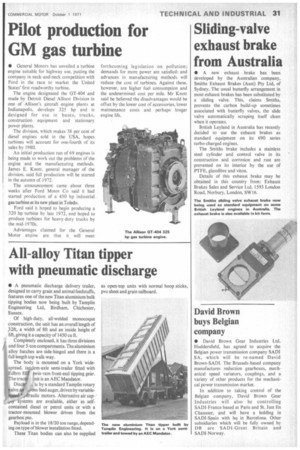Pilot production for GM gas turbine
Page 33

If you've noticed an error in this article please click here to report it so we can fix it.
• General Motors has unveiled a turbine engine suitable for highway use. putting the company in neck-and-neck competition with Ford in the race to market the United States' first roadworthy turbine.
The engine designated the GT-404 and made by Detroit Diesel Allison Division in one of Allison's aircraft engine plants at Indianapolis, develops 325 hp and is designed for use in buses, trucks, construction equipment and stationary power plants.
The division, which makes 38 per cent of diesel engines sold in the USA, hopes turbines will account for one-fourth of its sales by 1980.
An initial production run of 69 engines is being made to work out the problems of the engine and the manufacturing methods. James E. Knott. general manager of the division, said full production will be started in the autumn of 1972.
The announcement came about three weeks after Ford Motor Co said it had started production of a 450 hp industrial gas turbine at its new plant in Toledo.
Ford said it hoped to begin producing a 320 hp turbine by late 1972, and hoped to produce turbines For heavy-duty trucks by the mid-1970s.
Advantages claimed for the General Motor engine are that it will meet forthcoming legislation on pollution; demands for more power are satisfied: and advances in manufacturing methods will reduce the cost of turbines. Against these, however, are higher fuel consumption and the undetermined cost per mile. Mr Knott said he believed the disadvantages would be offset by the lower cost of accessories, lower maintenance costs and perhaps longer engine life.


















































































































